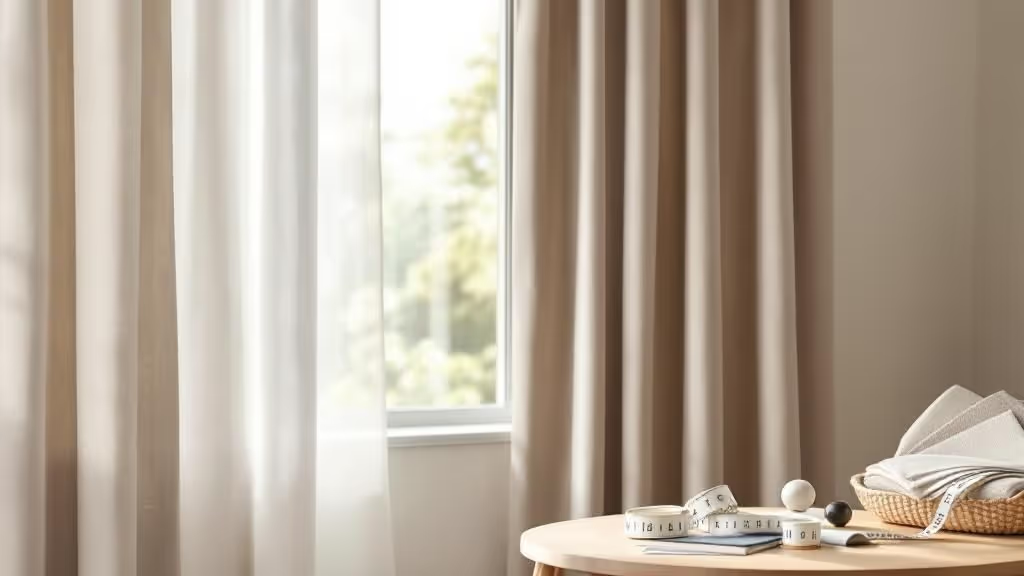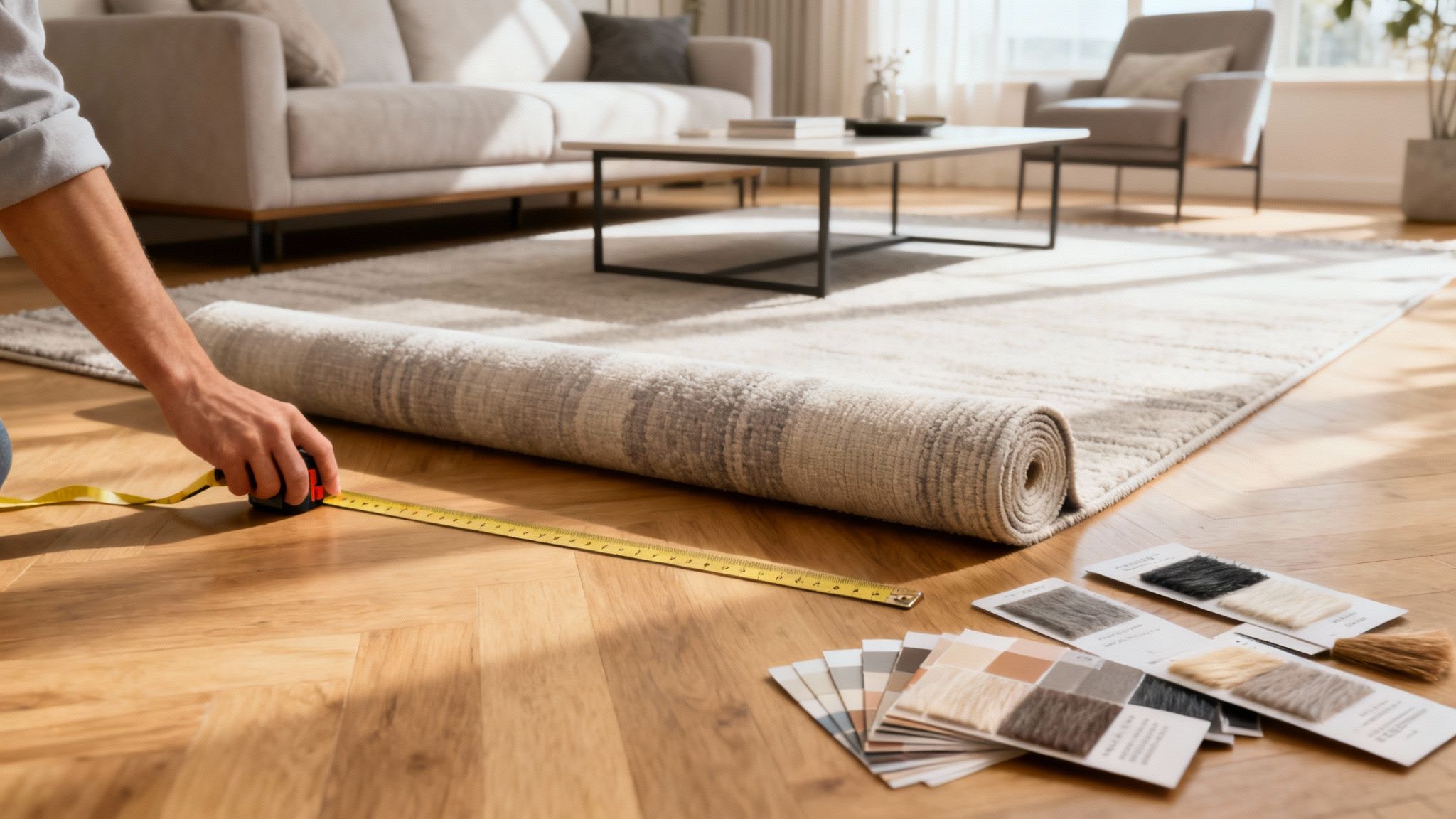Choosing the right curtains can be one of the most transformative updates you make to a room, and it's often simpler than you think. This guide will walk you through everything you need to know—from function and fabric to measuring and installation—to help you pick curtains that are both gorgeous and genuinely useful.
Defining Your Window Treatment Goals
Before you even think about diving into the wonderful world of fabrics and colours, let's take a step back. The absolute first step in any curtain project is figuring out what you actually need them to do. Think of it as creating a brief for your windows.
Without a clear goal, it’s far too easy to get overwhelmed by the sheer number of choices out there. You might end up with something that looks lovely but doesn't quite work for the room.
So, what job do your new curtains have? Answering this one question will make every other decision—from fabric weight to the type of pole you need—so much easier.
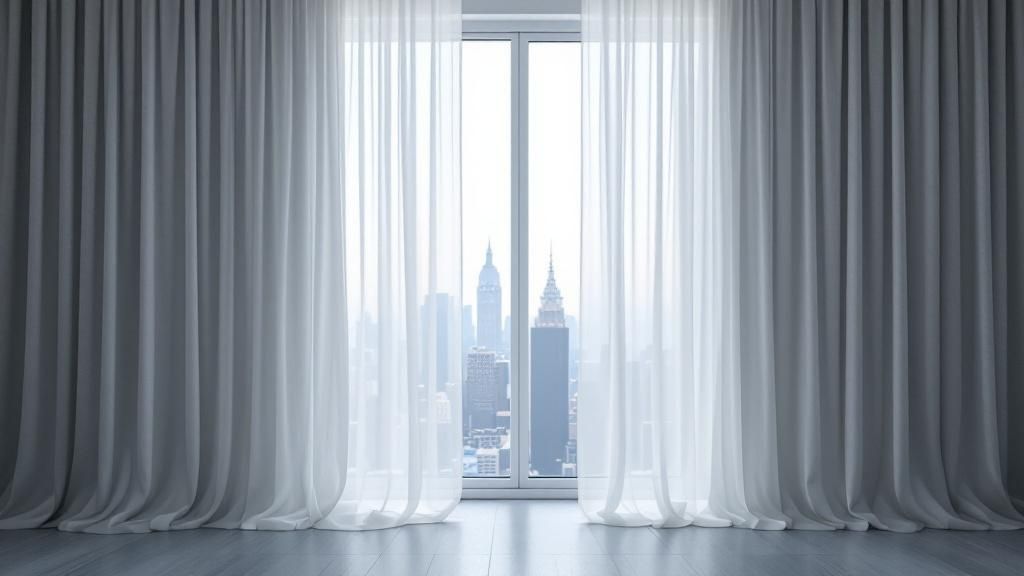
Identify Your Primary Function
Most window treatments wear a few different hats, but nailing down your main priority will help you cut through the noise. Take a moment to think about which of these is most important for your space.
- Enhancing Privacy: Are you trying to stop passers-by from peering into your ground-floor bedroom? Or maybe you just want to feel a bit more secluded in an overlooked living room? If so, sheer or unlined curtains probably won't cut it.
- Controlling Light: Is the goal to completely block out the morning sun for a better night's sleep? Or do you just need to soften the glare on your TV screen in the afternoon? This will dictate whether you need full blackout linings or can get away with lighter, light-filtering fabrics.
- Improving Insulation: Don't underestimate the power of curtains to fight off draughts and keep your home cosy. A good set of thick, properly fitted thermal curtains can slash heat loss by up to 25% in the winter.
- Making a Decorative Statement: Let's be honest, sometimes it's all about the look. Curtains are a fantastic way to inject colour, pattern, and texture, acting as that final flourish that ties a whole room together.
Setting a clear goal isn’t just about function; it’s about ensuring your investment delivers exactly what you need. A beautiful curtain that fails to block light in a bedroom is a design misstep.
Setting a Realistic Budget
Once you know what you need your curtains to do, it’s time to talk numbers. It's so important to remember that the cost is more than just the fabric panels.
A complete window treatment budget also needs to cover the curtain pole or track, any rings or hooks, the finials (the decorative ends!), and potentially installation costs if you're not planning to DIY.
Setting a realistic budget from the start helps narrow down your options and avoids any nasty surprises down the line. If you're looking for clever ways to refresh your space without breaking the bank, you can find more tips on affordable interior design to go with your new window dressings.
Choosing the Perfect Curtain Fabric
The fabric you choose is really the heart and soul of your curtains. It’s what dictates how they look, how they hang, and how they’ll hold up over time. Think of it like casting the main character in your room’s design story—it sets the entire tone.
A fabric’s weight, texture, and weave will influence everything from how much light filters through to how well they insulate a room. Getting this right is a huge part of buying curtains, as the perfect material brings both beauty and function to your windows.
Light and Airy Fabrics for a Casual Feel
For rooms where you want to invite in as much natural light as possible and create a relaxed, breezy vibe, lightweight fabrics are your best friend. They filter sunlight beautifully without blocking it completely, bathing your space in a soft, gentle glow.
- Cotton: A wonderfully versatile and easy-to-clean choice. Cotton gives you a crisp, clean finish that works with almost any decor style and drapes beautifully for a tailored look.
- Linen: Prized for its natural, slightly textured appearance, linen brings an effortlessly chic, organic feel to a room. It’s wonderfully light and airy, but just be aware that it does crease easily—though many would say that’s all part of its relaxed charm.
These materials are perfect for living rooms, kitchens, and dining areas where you’re not too worried about privacy and just want to maximise that lovely daylight. Their casual nature feels right at home in both modern and more traditional interiors. For more inspiration on how different materials play with light, you can explore our other lighting ideas for your home.
Rich and Heavy Fabrics for Drama and Warmth
If you’re aiming for a sense of luxury, want to improve insulation, or need to properly block out light, then heavier fabrics are the way to go. Their substantial weight gives them an excellent drape and a more formal, opulent look.
Velvet is a classic example. Its plush texture not only looks incredibly rich but also does a brilliant job of dampening sound and insulating the room. Likewise, materials like brocade or a heavy damask add a traditional elegance and weight that feels grand and sophisticated.
These choices are fantastic in bedrooms or formal living rooms, where creating a cosy, cocoon-like atmosphere is the goal.
Here in the UK, heavier drapes play a crucial role, especially with our colder climate. It's a common and very effective strategy to choose thermal or insulated curtains to help cut down on heat loss through windows.
This practical need is a big driver in the market. In fact, the UK window coverings industry was worth around USD 1.32 billion back in 2022. Curtains and drapes make up a huge chunk of that, thanks to our dual need for style and warmth.
The Power of Linings
Never, ever underestimate the importance of a good lining. A lining can completely transform a curtain's performance, adding substance to lighter fabrics and seriously boosting the capabilities of heavier ones.
- Blackout Lining: An absolute must for bedrooms. This thick, opaque layer blocks almost all incoming light, guaranteeing a dark room for a restful sleep.
- Thermal Lining: This features a clever layer of acrylic foam that acts as an insulator. It keeps rooms warmer in winter and cooler in summer, which can make a real difference to your energy bills.
- Standard Lining: Even a basic cotton or polyester lining will add body to your curtains, protect the main fabric from sun damage, and improve how beautifully they hang.
Finding the Right Curtain Style and Header
Once you’ve got your fabric sorted, the next big decision is the header style. This is the bit at the very top of the curtain that attaches to the pole or track, and it completely changes how the fabric hangs, folds, and even works day-to-day.
You can think of the header as the curtain's personality. A sleek, modern header creates those clean, uniform waves you see in magazines, while a more traditional, tightly gathered style gives a softer, classic feel. This one choice impacts the whole vibe of the room and even how much space the curtains take up when you pull them open.
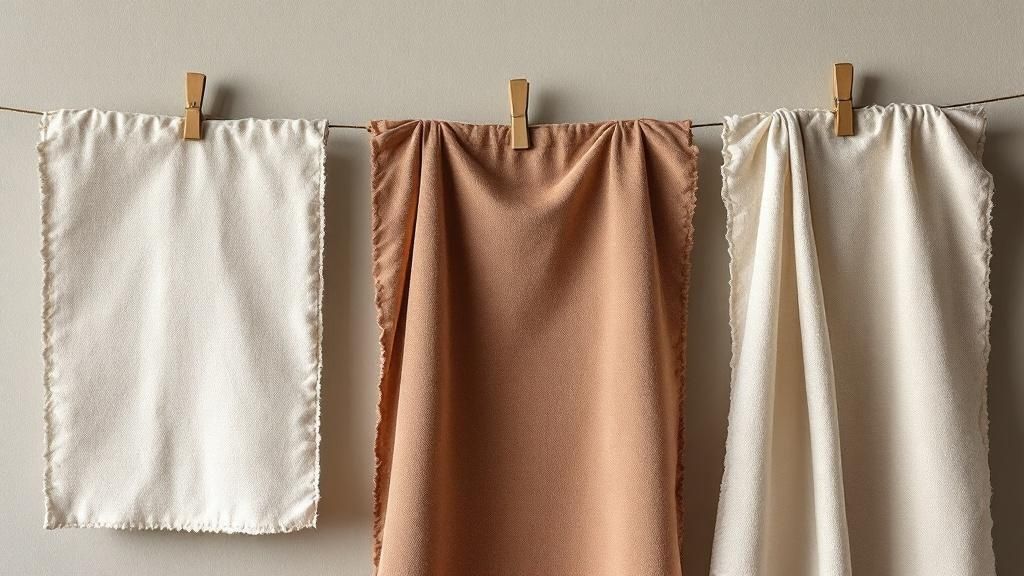
Common Header Styles Explained
Getting your head around the most popular options will help you match your curtains to your decor perfectly. Each style has its own look and feel, and they often work best with specific types of poles or tracks.
- Pencil Pleat: This is a timeless, traditional choice. The header has lots of thin, tightly packed folds that look a bit like a row of pencils, creating that classic gathered look. It’s a real all-rounder, working with both curtain poles and tracks.
- Eyelet (Grommet): If you’re after a contemporary and simple finish, eyelet headers are a brilliant option. Large metal rings are punched right into the fabric, so you just thread them straight onto a curtain pole. This style gives you lovely deep, soft, and even folds.
- Tab Top: This style has a much more casual, almost rustic vibe. Simple loops of fabric (the 'tabs') are sewn onto the top of the curtain panel, which then slide onto the pole. It's a charming look, perfect for cottage-style interiors.
Choosing a header isn't just about looks; it's a practical decision, too. Eyelet curtains, for example, glide open and closed with barely any effort, while pencil pleats offer a fuller, more luxurious appearance when they're drawn.
Matching Headers to Your Room
The header you pick should really sing in harmony with your room's overall aesthetic. An eyelet curtain might look a bit lost in a very traditional, ornate room, just as a formal pinch pleat could feel too stuffy for a laid-back, modern space.
This desire for a personalised home is a growing trend across the UK. The domestic curtain market is projected to hit around 128 million square metres by 2024, with more and more of us looking for sustainable fabrics and unique designs to make our homes our own. You can dive deeper into market analysis and discover more insights about UK curtain trends from IndexBox. Getting the header right is a massive part of that customisation journey.
How to Measure for Curtains Like a Pro
Getting your measurements right is probably the single most important step if you want that polished, professional look. Curtains that are even slightly off can make a beautiful room feel awkward and unfinished, but it’s actually quite simple to get a perfect fit every single time.
Think of it like getting a suit tailored for your window—precision is everything. This part of our guide will walk you through the foolproof process. All you'll need is a metal tape measure, a pencil and paper, and maybe a step ladder.
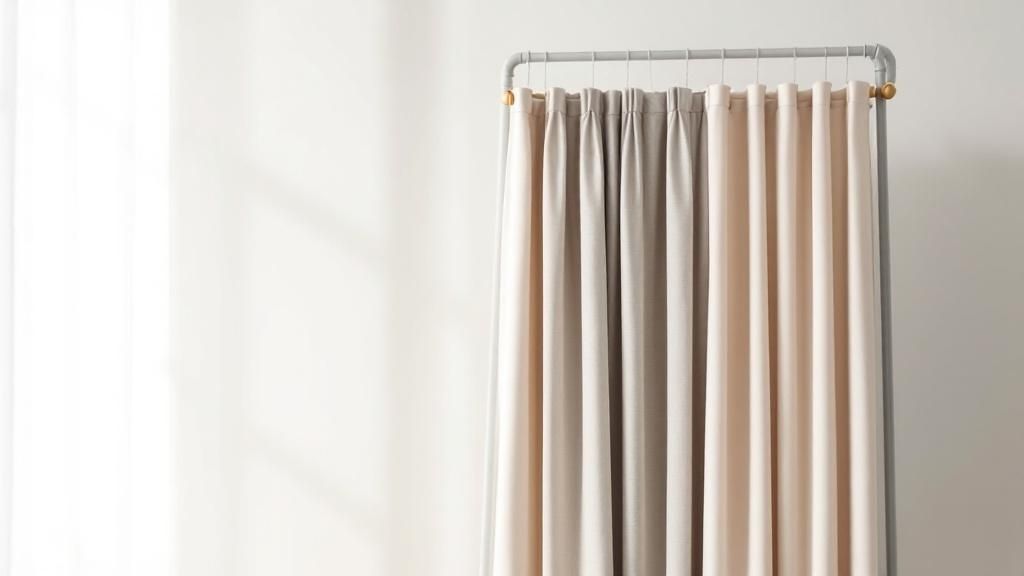
Step 1: Measure the Curtain Width
First things first, let's figure out the width. This measurement is what will give your curtains that full, luxurious look when they're closed. A flat, stretched-out curtain just looks a bit skimpy and can cheapen the whole effect.
You’ll want to measure the full length of your curtain pole or track, not the window itself. And don't include the decorative ends (the finials) in this measurement. A good rule of thumb is to have your pole extend about 15-25cm past the window frame on each side. This trick allows the curtains to be drawn back fully, letting as much natural light in as possible.
Step 2: Determine the Curtain Drop
Next up is the drop, or the length. This choice can dramatically change the feel of your room, and you’ve got three main options, each with its own distinct style.
- Sill Length: These curtains usually finish about 1cm above the windowsill. It's a really practical, neat choice, especially for kitchens or if you have a radiator right under the window.
- Below Sill: For a slightly more deliberate feel, having the curtains end around 15cm below the sill creates a lovely, balanced look without the fabric actually touching the floor.
- Floor Length: This is by far the most popular and elegant option. Curtains that just skim the floor (about 1cm above) give off a very tailored, high-end vibe and can even help make your ceilings feel taller.
A little tip from the pros: measure the drop in three different places—left, centre, and right. Floors and windowsills are rarely perfectly level, so using the shortest measurement of the three ensures your curtains will hang beautifully without dragging on the floor.
Once you know your desired length, where you measure from depends on your curtain header. For eyelet styles, measure right from the very top of the pole downwards. For pencil pleats hanging from a pole, you’ll measure from the small eye on the bottom of each curtain ring.
Step 3: Calculate for Fullness
Fullness is what gives curtains their gorgeous, gathered appearance. The amount of fabric you need all comes down to the header style you've chosen. After all, a flat panel of fabric just isn't very inviting, so you'll need to multiply your pole width to get the right amount of volume.
To make things easy, the table below gives you a quick way to work out the total curtain width you'll need based on your pole measurement.
Curtain Width Calculation Guide by Header Style
Getting the right fullness makes a huge difference in how your curtains frame the window and complete the room's aesthetic.
And for even more ways to elevate your space, take a look at these clever home improvement tips that can make a surprisingly big impact.
Selecting Your Curtain Poles and Hardware
Don't just think of curtain hardware as the nuts and bolts of the operation. It’s so much more than a functional bracket; it's the jewellery for your window. Think of it as the frame for your artwork—it’s there to support the main event, but it also adds its own distinct character, tying the whole look together with a final flourish.
Choosing the right pole or track is a massive part of getting your curtains right. It’s not just about making sure your curtains hang beautifully (though that’s obviously key). It’s about complementing your room’s entire vibe, whether you're going for rustic charm or sleek modernism. Get this detail right, and you’ll elevate the whole window treatment from just ‘nice’ to ‘wow’.
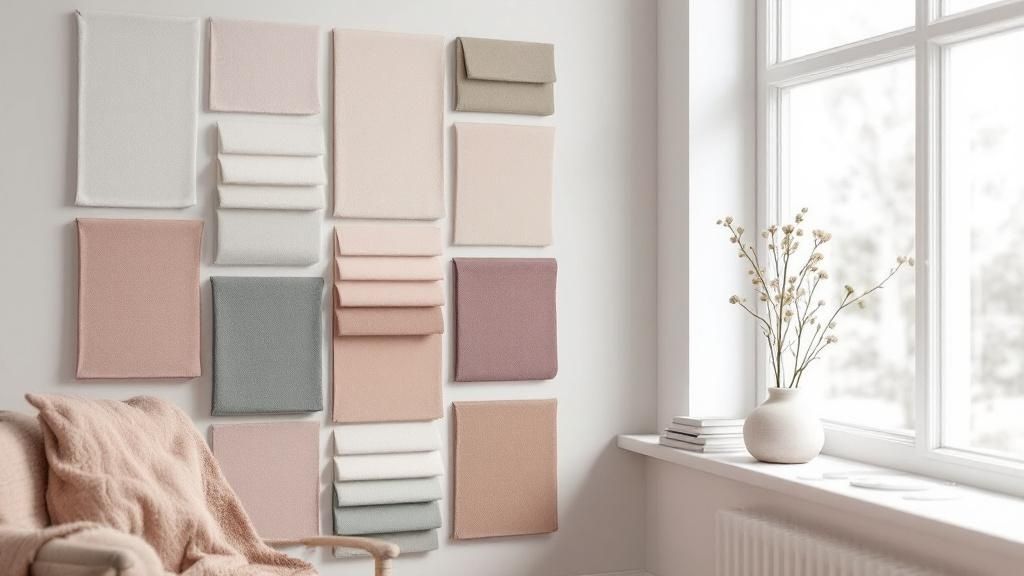
Poles Versus Tracks
First things first: are you a pole person or a track person? Each offers a completely different look and serves a slightly different function, so the best choice really comes down to your curtains and your window.
Curtain Poles: These are designed to be seen and admired. They come in a massive range of materials and finishes—think classic wood, industrial matte black, or elegant brass—and they really act as a style statement in their own right. They are the perfect partner for eyelet and tab top curtains.
Curtain Tracks: These are the strong, silent type. They’re more functional and discreet, often made from plastic or metal. You can bend them to fit tricky spaces like bay windows, and they’re usually hidden by the curtain fabric itself. They’re absolutely ideal for traditional pencil pleat headers.
Choosing Materials and Finishes
Once you've landed on either a pole or a track, it’s time for the fun part: thinking about materials. This is where you can really start to coordinate with your existing decor. A warm, chunky wooden pole might feel right at home in a cosy, traditional living room, while a slim, brushed nickel pole can add a clean, contemporary edge to a more modern space.
When you're picking a finish, have a quick scan of the other metallic or wooden tones in your room. Keeping these small details consistent is what creates that cohesive, professionally designed feel and stops a space from looking cluttered or accidental.
If you're after a properly up-to-date look, think about materials that are having a moment right now. You can discover more about what's popular in our guide to the latest interior design trends for 2024.
The Finishing Touches
Finally, let's not forget the small but mighty details that really complete the picture. These little accessories are crucial for both the final look and how your curtains work day-to-day.
- Finials: These are the decorative caps on the ends of a curtain pole. They can be anything from a simple, understated ball to an ornate, carved floral design. This is where you can add a final dash of personality.
- Rings: It might sound obvious, but make sure you have enough rings for your curtain width. This allows them to open and close smoothly without snagging. And of course, they should match or complement your pole's finish.
- Tie-Backs: These are what hold your curtains neatly open during the day, letting all that lovely light flood in. They come in all sorts of forms, from simple fabric bands to decorative metal hooks.
Essential Curtain Care and Maintenance
So, you’ve invested in the perfect curtains. They look incredible, but how do you keep them that way? Getting them clean and keeping them fresh is the secret to making them last, ensuring they look just as stunning years down the line as they did on day one.
Think of your curtains like any other fabric in your home – each one needs a slightly different touch. Before you do anything, the golden rule is to check the care label. A quick peek can save you from a world of hurt, like accidental shrinkage or colours running where they shouldn't.
Routine Cleaning and Upkeep
A little and often is a much better approach than a massive deep clean every six months. Dust has a nasty habit of working its way deep into the fibres, which dulls the colour and can even weaken the fabric over time.
A quick once-over each week will do the trick. Just grab your vacuum, pop on the brush attachment, set it to low suction, and gently run it down the curtains. If you're dealing with something more delicate like silk or a sheer voile, a feather duster or even a good old-fashioned shake will get rid of most of the dust.
Keeping your curtains clean is about more than just looks—it’s good for your home's air quality, too. Fabrics are brilliant at trapping allergens like dust mites and pollen, so a regular hoover helps everyone breathe a little easier.
Deep Cleaning by Fabric Type
When it’s time for a proper wash, the fabric is your guide.
- Machine Washable: Tougher materials like cotton and polyester can usually handle a cool, gentle cycle in the machine. Just be sure to wash them on their own to prevent snagging and hang them up to dry straight away to stop creases from setting in.
- Dry Clean Only: This is a non-negotiable for the fancy stuff. Fabrics like velvet, silk, and brocade need a professional touch, as water and home detergents can easily ruin them.
- Spot Cleaning: For a small spill on a fabric you can't wash, speed is key. Gently blot the stain with a clean, damp cloth and a tiny bit of mild soap. Always, always test it on a hidden spot first, like the hem at the back.
Got a Few Lingering Questions?
Alright, let's tackle some of those common questions that pop up right before you're ready to buy. Think of this as a final sanity check to make sure you've got everything sorted. We'll clear up any last-minute wobbles so you can feel totally confident in your choices.
Ready-Made or Custom-Made?
This is a big one. So, what’s the difference? Ready-made curtains are your off-the-shelf heroes – they're wallet-friendly, available straight away, and come in standard sizes. On the flip side, custom curtains are made-to-measure, fitting your window like a glove and giving you endless choices for fabrics and styles.
It really boils down to your priorities. If you've got standard windows and a set budget, ready-made is a brilliant choice. But for quirky window sizes or a really specific look you're dreaming of, investing in custom is the way to go for that perfect, polished finish.
Can I Layer Curtains with Blinds?
You absolutely can, and it's a fantastic designer trick! Combining curtains and blinds gives you the ultimate control over light and privacy. A popular setup is to fit a practical blind (like a roller or Venetian) inside the window frame, and then hang your more decorative curtains on a pole outside it.
This layered approach adds so much depth and texture, instantly making a space feel more put-together. It’s one of our favourite ways to make a room feel extra snug. For more ideas like this, check out our guide on how to make a room cozy.
Should My Curtains Be Hung High and Wide?
Yes, yes, and yes! This is probably the best-kept secret for making any room feel bigger and brighter. Hanging your curtain pole well above and beyond the window frame works a bit of magic.
Here's how it works:
- Go Higher: Mount the pole at least 15-25cm above the top of the window frame. This simple move draws your gaze upwards, creating the illusion of a higher ceiling.
- Go Wider: Extend the pole 15-25cm past the frame on each side. This means that when the curtains are open, they hang against the wall instead of covering the glass, letting in maximum light and making your window feel much grander.

